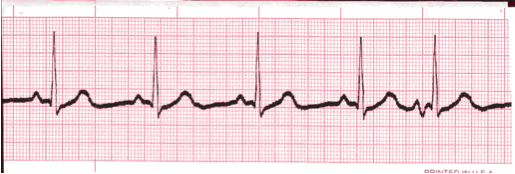Step 2 Heart Rate Regular - Cardiac Rhythms
Regular Rhythms
- If the rhythm varies by less than two small boxes, then the rhythm is considered regular.
- The heart rate determination technique used will be the 1500 technique.
- Starting at the beginning of the tracing through the end, measure from one R wave to the next R wave (ventricular assessment), then P wave to P wave (atrial assessment), then count the number of small boxes between each and divide that number into 1500.
- This technique will give you the most accurate heart rate when analyzing regular heart rhythms. You may include ½ of a small box i.e. 37.5/1500 = 40 bpm (don’t forget to round up or down if a portion of a beat is included in the answer).

Irregular Rhythms
- If the rhythm varies by two small boxes or more, the rhythm is considered “irregular”.
- The heart rate determination technique used for irregular rhythms will be the “six-second technique”.
- Simply count the number of complete cardiac complexes in six seconds and multiply by ten.

Practice 1
Analyze this tracing. What is the heart rate?

Analyze this tracing. What is the heart rate?
Reveal Answer
Regular Rhythm – 1500 technique – 22 small boxes divided into 1500 = 68.18. Rate: 68 bpmPractice 2

Analyze this tracing. What is the heart rate?
Reveal Answer
Irregular Rhythm – Six-second technique – 5 complete complexes. Rate: 50 bpm.Authors and Sources
Authors and Reviewers
- EKG heart rhythm modules: Thomas O'Brien.
- EKG monitor simulation developer: Steve Collmann
-
12 Lead Course: Dr. Michael Mazzini, MD.
- Spanish language EKG: Breena R. Taira, MD, MPH
- Medical review: Dr. Jonathan Keroes, MD
- Medical review: Dr. Pedro Azevedo, MD, Cardiology
- Last Update: 11/8/2021
Sources
-
Electrocardiography for Healthcare Professionals, 5th Edition
Kathryn Booth and Thomas O'Brien
ISBN10: 1260064778, ISBN13: 9781260064773
McGraw Hill, 2019 -
Rapid Interpretation of EKG's, Sixth Edition
Dale Dublin
Cover Publishing Company -
12 Lead EKG for Nurses: Simple Steps to Interpret Rhythms, Arrhythmias, Blocks, Hypertrophy, Infarcts, & Cardiac Drugs
Aaron Reed
Create Space Independent Publishing -
Heart Sounds and Murmurs: A Practical Guide with Audio CD-ROM 3rd Edition
Elsevier-Health Sciences Division
Barbara A. Erickson, PhD, RN, CCRN -
The Virtual Cardiac Patient: A Multimedia Guide to Heart Sounds, Murmurs, EKG
Jonathan Keroes, David Lieberman
Publisher: Lippincott Williams & Wilkin)
ISBN-10: 0781784425; ISBN-13: 978-0781784429 - Project Semilla, UCLA Emergency Medicine, EKG Training Breena R. Taira, MD, MPH